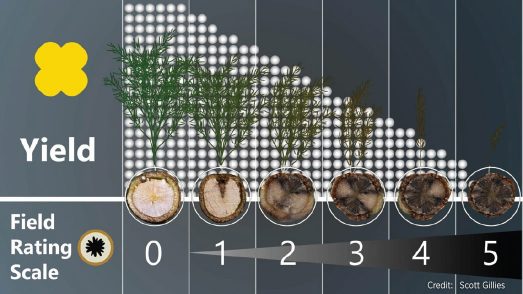First yield-loss model for blackleg on the Prairies
Key result: This study quantified how reducing blackleg can substantially improve canola yields. Growers should continue to select blackleg-resistant canola varieties and follow best-practice recommendations to manage this disease.
Project title, Principal investigator: “Development of a blackleg yield loss model and assessment of fungicide resistance in Western Canadian populations of Leptosphaeria maculans,” Stephen Strelkov, University
of Alberta
Funding: SaskCanola, Alberta Canola, GF2
Blackleg in Canada has been managed largely through the use of resistant cultivars. But in recent years the virulence of Leptosphaeria maculans populations has shifted, resulting in the erosion of genetic resistance. This loss of resistance became evident in 2012 when many canola crops sown to resistant (R) and moderately-resistant (MR) cultivars were heavily infected with blackleg and suffered severe yield losses.
This four-year study led by University of Alberta’s Stephen Strelkov aimed to establish the relationship between blackleg disease severity and canola yield loss and to determine if there is any fungicide resistance in L. maculans populations from Western Canada. The project objectives included development of a yield-loss model and ensuring sustainability of fungicide approaches to blackleg management.

In each year of the study, greenhouse and field experiments were conducted to determine the relationship between blackleg disease severity and yield in a susceptible cultivar (Westar) and in MR (1950RR) to R (46S53RR) canola hybrids. As expected, disease severity in the R and MR varieties was lower than in the susceptible variety over all site years. There were also significant differences in number of pods per plant with 46S53RR having the greatest and Westar the lowest. Seed yield was also 120-128 per cent greater for 46S53RR and 1950RR.
Regression analysis showed that pod number and seed yield declined as disease severity increased in all site years. There were considerable variations among the site years with pod number decreasing by 18-45 per plant and seed yield decreasing by 0.92-2.65 g per plant for every one-point increase in disease severity. When averaged over five site-years, this transforms to estimated yield losses in Westar of 17.2 per cent for each point increase in blackleg severity based on the 0-5 severity scale shown in the diagram.
Fungicide objective
Strobilurin fungicides can be used to manage blackleg of canola, but they have a high risk of selecting for resistance in fungal populations. To assess fungicide sensitivity, a total of 117 single-spore L. maculans isolates were collected from infected canola residues in six fields located in the Alberta counties of Camrose, Lacombe, Ponoka, Strathcona and Wetaskiwin.
The isolates were grown on fungicide-amended agar plates and growth inhibition was calculated in comparison to non-amended controls. The effective concentration of pyraclostrobin fungicide needed to inhibit growth by 50 per cent was determined to be 0.09 mg per litre based on 13 randomly selected isolates. To identify fungicide resistance, a discriminatory dose 69-fold greater was used to screen all 117 isolates where <50 per cent growth inhibition would be considered insensitive. Resulting values ranged from 66.6 to 100 per cent with a mean of 84.3 per cent, indicating that all of the isolates were sensitive to pyraclostrobin. However, these isolates represented a relatively small number of fields and additional work will be required to confirm this conclusion for subsequent monitoring of shifts in sensitivity.
While most canola cultivars grown in Alberta have moderate to high resistance to blackleg, there is always a risk that genetic resistance will be overcome, especially if the same cultivar is planted repeatedly in short rotations. Growers should continue to select blackleg-resistant canola varieties and follow best practices for residue management and crop rotation.
From this study, the first yield-loss model for blackleg of canola has been developed for Western Canada. This is important information both for informed pest management decisions and for communicating with external stakeholders.
PEER-REVIEWED JOURNAL ARTICLES: Fraser, M., Hwang, S.F., Ahmed, H.U., Akhavan, A., Stammler, G., Barton, W., and Strelkov, S.E. 2017. Sensitivity of Leptosphaeria maculans to pyraclostrobin in Alberta, Canada. Can J. Plant Sci., 97(1): 83-91 Hwang, S.F., Strelkov, S.E., Peng, G., Ahmed, H.U., Zhou, Q., and Turnbull, G.D. 2016. Blackleg (Leptosphaeria maculans) severity and yield loss in canola in Alberta, Canada. Plants, 5(3), 31 (11pp). DOI 10.3390/plants5030031





